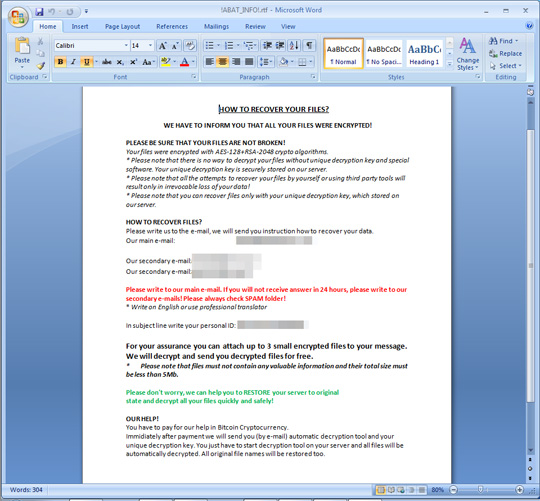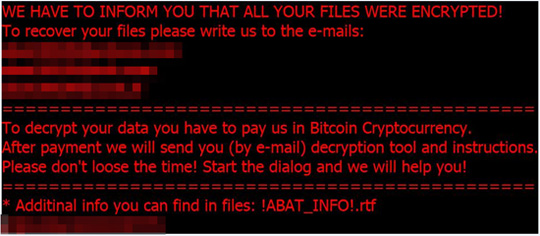Ransom.Win32.MATRIX.AF
W32/Matrix.2FFD!tr.ransom (FORTINET); Trojan-Ransom.Matrix (IKARUS)
Windows


Threat Type: Ransomware
Destructiveness: No
Encrypted:
In the wild: Yes
OVERVIEW
Downloaded from the Internet, Dropped by other malware
This Ransomware arrives on a system as a file dropped by other malware or as a file downloaded unknowingly by users when visiting malicious sites.
It connects to certain websites to send and receive information.
TECHNICAL DETAILS
1,221,120 bytes
EXE
Yes
26 Sep 2019
Connects to URLs/IPs, Encrypts files, Displays message/message boxes, Deletes files
Arrival Details
This Ransomware arrives on a system as a file dropped by other malware or as a file downloaded unknowingly by users when visiting malicious sites.
Installation
This Ransomware drops the following copies of itself into the affected system and executes them:
- {Malware Path}\{random characters}.exe
It drops the following files:
- {Malware Path}\ALL_CrDfLDmp.tmp
- {Malware Path}\log.txt
- %Application Data%\{random characters}.bmp → used as wallpaper
- %Application Data%\{random characters}.bat → contains commands to remove volume shadow copies and disable system recovery
- %Application Data%\{random characters}.vbs → contains commands to create scheduled task
- {Malware Path}\{random characters}.exe → used for file handle manipulation
- {Malware Path}\{random characters}.bat → contains commands to take ownership of a file
(Note: %Application Data% is the current user's Application Data folder, which is usually C:\Documents and Settings\{user name}\Application Data on Windows 2000(32-bit), XP, and Server 2003(32-bit), or C:\Users\{user name}\AppData\Roaming on Windows Vista, 7, 8, 8.1, 2008(64-bit), 2012(64-bit) and 10(64-bit).)
It adds the following processes:
- {Malware Path}\{8 random characters}.exe -n → if run without argument
It adds the following mutexes to ensure that only one of its copies runs at any one time:
- MutexABAT → if run without argument
- MutexABATDONW → if run with argument
Other System Modifications
This Ransomware deletes the following files:
- %Application Data%\{random characters}.vbs
- %Application Data%\{random characters}.bat
(Note: %Application Data% is the current user's Application Data folder, which is usually C:\Documents and Settings\{user name}\Application Data on Windows 2000(32-bit), XP, and Server 2003(32-bit), or C:\Users\{user name}\AppData\Roaming on Windows Vista, 7, 8, 8.1, 2008(64-bit), 2012(64-bit) and 10(64-bit).)
It changes the desktop wallpaper by modifying the following registry entries:
HKEY_CURRENT_USER\Control Panel\Desktop
Wallpaper = %Application Data%\{random characters}.bmp
HKEY_CURRENT_USER\Control Panel\Desktop
WallpaperStyle = 0
HKEY_CURRENT_USER\Control Panel\Desktop
TileWallpaper = 0
It sets the system's desktop wallpaper to the following image:
Other Details
This Ransomware connects to the following website to send and receive information:
- http://{BLOCKED}u.host/addrecord.php?apikey=abat_api_key&compuser={username}-PC{username}&sid=Q8x0bgxGTfMRkCsQ&phase=START
It encrypts files with the following extensions:
- .mdf
- .ndf
- .ldf
- .myd
- .eql
- .sql
- .vhd
- .sqlite
- .sqlite3
- .sqlitedb
- .hwp
- .hwt
- .hml
- .hwdt
- .hwpx
- .cell
- .nxl
- .hcdt
- .nxts
- .how
- .hpt
- .hsdt
- .xlsx
- .xls
- .docx
- .doc
- .dot
- .dotx
- .odt
- .ods
- .bak
- .tib
- .dbs
- .db
- .dbk
- .db2
- .db3
- .dbc
- .dt
- .dbs
- .dbf
- .dbx
- .mdb
- .sdf
- .ndf
- .ns2
- .ns3
- .ns4
- .nsf
- .accdb
- .vpd
- .dwg
- .cdr
- .jpg
- .jpeg
- .psd
- .zip
- .rar
- .7z
- .tar
- .gz
It does the following:
- It retrieves the following information:
- Computer name
- User name
- System integrity level
- It avoids encrypting files with the following file extensions:
- .vbs
- .rtf
- .bmp
- .tmp
- .rdp
- .sek
- .ico
- .dll
- .blf
- .rbs
- .regtrans-ms
- .settingcontent-ms
- .search-ms
- .log
- .xml
- .log1
- .log2
- It avoids encrypting the following files:
- ntuser.dat
- ntuser.pol
- ntuser.dat.log
- ntuser.dat.log1
- ntuser.dat.log2
- iconcache.db
- thumbs.db
- bootsect.bak
- bootmgr
- default.rdp
- pagefile.sys
- hiberfil.sys
- swapfile.sys
- wordpad.exe
- It encrypts files located in the following locations:
- Shared drives
- Removable drives
- Fixed drives
- Ramdisk
- It deletes shadow copies by executing the following commands:
- vssadmin Delete Shadows /All /Quiet
- wmic SHADOWCOPY DELETE
- It disables system recovery by executing the following commands:
- bcdedit /set {default} recoveryenabled No
- bcdedit /set {default} bootstatuspolicy ignoreallfailures
- It deletes the scheduled task with the following task name:
- DSHCA
It accepts the following parameters:
- "-n" if not run with parameters
It adds the following scheduled tasks:
- Task name: DHSCA
Schedule: Every 5 minutes
Task to be run: %Application Data%\{random characters}.bat
(Note: %Application Data% is the current user's Application Data folder, which is usually C:\Documents and Settings\{user name}\Application Data on Windows 2000(32-bit), XP, and Server 2003(32-bit), or C:\Users\{user name}\AppData\Roaming on Windows Vista, 7, 8, 8.1, 2008(64-bit), 2012(64-bit) and 10(64-bit).)
Ransomware Routine
This Ransomware avoids encrypting files found in the following folders:
- WINDOWS SIDEBAR
- WINDOWS MEDIA PLAYER
- DVD MAKER
- WINDOWSPOWERSHELL
- WINDOWSDEFENDER
- TORBROWSER
- ASPNET_CLIENT
- REFERENCE ASSEMBLIES
- MICROSOFT\PROVISIONING
- MICROSOFT SILVERLIGHT
- PROGRAMDATA\MICROSOFT
- MICROSOFT\CRYPTO
- WINDOWSAPPS
- 7-ZIP
- WINRAR
- ESET
- AVAST
- MALWAREBYTES
- SYMANTEC ENDPOINT
- TREND MICRO
- BITDEFENDER
- PANDA SECURITY
- MCAFEE
- GAMMA08
- WINDOWS
- WINDOWS.OLD
- WINDOWS10UPGRADE
- $RECYCLE.BIN
- WINDOWS NT
- COMMON FILES
- TEMP
- BOOT
- MSOCACHE
- DEFAULT USER
- FILES\ACRONIS
- (X86)\ACRONIS
- FILES\BACKUPCLIENT
- (X86)\BACKUPCLIENT
- FILES\BACKUPMANAGER
- (X86)\BACKUP MANAGER
- FILES\CARBONITE
- (X86)\CARBONITE
- FILES\GOOGLE\DRIVE
- (X86)\GOOGLE\DRIVE
- FILES\DROPBOX
- (X86)\DROPBOX
- FILES\MICROSOFT ONEDRIVE
- (X86)\MICROSOFT ONEDRIVE
- FILES\ONEDRIVE
- (X86)\ONEDRIVE
- VNC
- INTERNET EXPLORER
- MICROSOFT\OFFICE
- MICROSOFT OFFICE
- KASPERSKY LAB
- KASPERSKYLAB
- AVDEFENDER
- SOPHOS
- AVG
It renames encrypted files using the following names:
- [{BLOCKED}19@yahoo.com].{8 random characters}-{8 random characters}.ABAT
It leaves text files that serve as ransom notes containing the following text:
- !ABAT_INFO!.rtf

SOLUTION
9.850
15.392.05
26 Sep 2019
15.393.00
26 Sep 2019
Step 1
Trend Micro Predictive Machine Learning detects and blocks malware at the first sign of its existence, before it executes on your system. When enabled, your Trend Micro product detects this malware under the following machine learning name:
-
Troj.Win32.TRX.XXPE50FFF031
Step 2
Before doing any scans, Windows 7, Windows 8, Windows 8.1, and Windows 10 users must disable System Restore to allow full scanning of their computers.
Step 3
Note that not all files, folders, and registry keys and entries are installed on your computer during this malware's/spyware's/grayware's execution. This may be due to incomplete installation or other operating system conditions. If you do not find the same files/folders/registry information, please proceed to the next step.
Step 4
Restart in Safe Mode
Step 5
Reset your Desktop properties
Step 6
Restart in normal mode and scan your computer with your Trend Micro product for files detected as Ransom.Win32.MATRIX.AF. If the detected files have already been cleaned, deleted, or quarantined by your Trend Micro product, no further step is required. You may opt to simply delete the quarantined files. Please check this Knowledge Base page for more information.
Step 7
Restore encrypted files from backup.
Step 8
Scan your computer with your Trend Micro product to delete files detected as Ransom.Win32.MATRIX.AF. If the detected files have already been cleaned, deleted, or quarantined by your Trend Micro product, no further step is required. You may opt to simply delete the quarantined files. Please check the following Trend Micro Support pages for more information:
Step 9
Search and delete these files
- {Malware Path}\{random characters}.exe
- {Malware Path}\ALL_CrDfLDmp.tmp
- {Malware Path}\log.txt
- %Application Data%\{random characters}.bmp
- {Malware Path}\{random characters}.exe
- {Malware Path}\{random characters}.bat
- {Encrypted Directory}\#ABAT_INFO#.rtf
NOTES:
- Enabling Volume Shadow Service
- Run the command prompt (cmd.exe) as administrator.
- Enable Volume Shadow Service using the following command: net start vss
- Enabling Windows Error Recovery
- Run the command prompt (cmd.exe) as administrator.
- Enable windows error recovery screen on startup using the following command: bcdedit /set {default} bootstatuspolicy displayallfailures
Did this description help? Tell us how we did.


